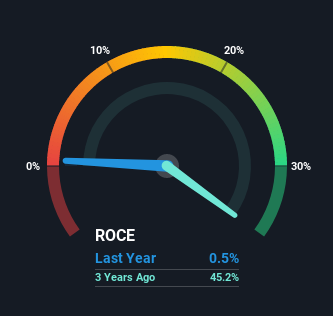Allied Farmers (NZSE:ALF) Is Reinvesting At Lower Rates Of Return
Did you know there are some financial metrics that can provide clues of a potential multi-bagger? Firstly, we'd want to identify a growing return on capital employed (ROCE) and then alongside that, an ever-increasing base of capital employed. If you see this, it typically means it's a company with a great business model and plenty of profitable reinvestment opportunities. In light of that, when we looked at Allied Farmers (NZSE:ALF) and its ROCE trend, we weren't exactly thrilled.
What is Return On Capital Employed (ROCE)?
For those that aren't sure what ROCE is, it measures the amount of pre-tax profits a company can generate from the capital employed in its business. Analysts use this formula to calculate it for Allied Farmers:
Return on Capital Employed = Earnings Before Interest and Tax (EBIT) ÷ (Total Assets - Current Liabilities)
0.005 = NZ$72k ÷ (NZ$25m - NZ$10m) (Based on the trailing twelve months to December 2020).
Therefore, Allied Farmers has an ROCE of 0.5%. Ultimately, that's a low return and it under-performs the Food industry average of 7.7%.
View our latest analysis for Allied Farmers
Historical performance is a great place to start when researching a stock so above you can see the gauge for Allied Farmers' ROCE against it's prior returns. If you're interested in investigating Allied Farmers' past further, check out this free graph of past earnings, revenue and cash flow.
So How Is Allied Farmers' ROCE Trending?
On the surface, the trend of ROCE at Allied Farmers doesn't inspire confidence. To be more specific, ROCE has fallen from 44% over the last five years. Given the business is employing more capital while revenue has slipped, this is a bit concerning. If this were to continue, you might be looking at a company that is trying to reinvest for growth but is actually losing market share since sales haven't increased.
On a side note, Allied Farmers has done well to pay down its current liabilities to 42% of total assets. That could partly explain why the ROCE has dropped. Effectively this means their suppliers or short-term creditors are funding less of the business, which reduces some elements of risk. Since the business is basically funding more of its operations with it's own money, you could argue this has made the business less efficient at generating ROCE. Either way, they're still at a pretty high level, so we'd like to see them fall further if possible.
The Bottom Line
From the above analysis, we find it rather worrisome that returns on capital and sales for Allied Farmers have fallen, meanwhile the business is employing more capital than it was five years ago. In spite of that, the stock has delivered a 28% return to shareholders who held over the last five years. Regardless, we don't like the trends as they are and if they persist, we think you might find better investments elsewhere.
Allied Farmers does have some risks, we noticed 3 warning signs (and 1 which is a bit concerning) we think you should know about.
While Allied Farmers isn't earning the highest return, check out this free list of companies that are earning high returns on equity with solid balance sheets.
This article by Simply Wall St is general in nature. It does not constitute a recommendation to buy or sell any stock, and does not take account of your objectives, or your financial situation. We aim to bring you long-term focused analysis driven by fundamental data. Note that our analysis may not factor in the latest price-sensitive company announcements or qualitative material. Simply Wall St has no position in any stocks mentioned.
Have feedback on this article? Concerned about the content? Get in touch with us directly. Alternatively, email editorial-team (at) simplywallst.com.

